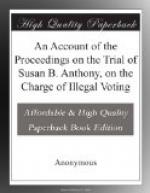First—That the defendant had a lawful right to vote.
Second—That whether she had a lawful right to vote or not, it she honestly believed that she had that right and voted in good faith in that belief, she was guilty of no crime.
Third—That when she gave her vote she gave it in good faith, believing that it was her right to do so.
That the two first propositions presented questions for the Court to decide, and the last for the jury.
When the counsel had proceeded thus far, the Court suggested that the counsel had better discuss in the first place the questions of law; which the counsel proceeded to do, and having discussed the two legal questions at length, asked leave then to say a few words to the jury on the question of fact. The Court then said to the counsel that he thought that had better be left until the views of the Court upon the legal questions should be made known.
The District Attorney thereupon addressed the Court at length upon the legal questions, and at the close of his argument the Court delivered an opinion adverse to the positions of the defendant’s counsel upon both of the legal questions presented, holding that the defendant was not entitled to vote; and that if she voted in good faith in the belief in fact that she had a right to vote, it would constitute no defense—the grounds of the decision on the last point being that she was bound to know that by law she was not a legal voter, and that even if she voted in good faith in the contrary belief, it constituted no defense to the crime with which she was charged. The decision of the Court upon these questions was read from a written document.
At the close of the reading, the Court said that the decision of these questions disposed of the case and left no question of fact for the jury, and that he should therefore direct the jury to find a verdict of guilty, and proceeded to say to the jury that the decision of the Court had disposed of all there was in the case, and that he directed them to find a verdict of guilty, and he instructed the clerk to enter a verdict of guilty.
At this point, before any entry had been made by the clerk, the defendant’s counsel asked the Court to submit the case to the jury, and to give to the jury the following several instructions:
First—That if the defendant, at the time of voting, believed that she had a right to vote, and voted in good faith in that belief, she is not guilty of the offence charged.
Second—In determining the question whether she did or did not believe that she had a right to vote, the jury may take into consideration, as bearing upon that question, the advice which she received from the counsel to whom she applied.
Third—That they may also take into consideration as bearing upon the same question, the fact that the inspectors considered the question, and came to the conclusion that she had a right to vote.




